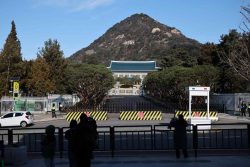
FILE PHOTO: A woman stands above Nadiia Chuhai lying in her bed inside Azot chemical plant’s bomb shelter, where people have been hiding from from shelling since the beginning of the war, in Sievierodonetsk, Luhansk region, Ukraine, April 16, 2022.
9:49 JST, June 15, 2022
KYIV (Reuters) – Russia told Ukrainian forces holed up in a chemical plant in embattled Sievierodonetsk to lay down their arms by early Wednesday as it fights to maintain momentum in its battle for control of eastern Ukraine.
Ukraine is calling for an increase in Western heavy weapons after Russia committed the bulk of its firepower to the eastern Donbas region, a topic expected to feature prominently at a meeting of NATO defence ministers on Wednesday in Brussels.
Ukraine says more than 500 civilians are trapped alongside soldiers inside Azot, a chemical factory where its forces have resisted weeks of Russian bombardment and assaults that have reduced much of Sievierodonetsk to ruins.
Fighters should “stop their senseless resistance and lay down arms” from 8 a.m. Moscow time (0500 GMT), Mikhail Mizintsev, head of Russia’s National Defence Management Centre told the Interfax news agency.
Civilians would be let out through a humanitarian corridor, Mizintsev said.
The Azot bombardment echoes earlier battles over the Azovstal steelworks in the southern port of Mariupol, where hundreds of fighters and civilians took shelter from Russian shelling. Those inside surrendered in mid-May and were taken into Russian custody.
Shelling on Azot was so strong that “people can no longer stand it in the shelters, their psychological state is on edge,” said regional governor Serhiy Gaidai of Luhansk, one of two eastern provinces Moscow claims on behalf of separatist proxies.
The battle for Luhansk’s Sievierodonetsk – a city of barely more than 100,000 people before the war – is now the biggest fight in Ukraine as the conflict has become a war of attrition.
Ukraine is still trying to evacuate civilians after Russian forces destroyed the last bridge to the city. Ground has changed hands several times over the past few weeks, and Ukrainian officials have given little indication they will back down.
“We have to hold strong … The more losses the enemy suffers, (the) less strength it will have to pursue its aggression,” Zelenskiy said in an address late Tuesday.
‘Unable to leave’
Ukraine still holds Lysychansk, Sievierodonetsk’s twin city on higher ground on the western bank of the Siverskyi Donets river. But with all the bridges now cut, its forces acknowledge a threat that they could be encircled.
Kyiv has said 100-200 of its soldiers are killed each day, with hundreds more wounded.
Russia gives no regular figures of its own losses but Western countries say they have been massive as President Vladimir Putin seeks to force Kyiv to cede full control of two provinces, Luhansk and Donetsk, collectively known as the Donbas.
Momentum in Sievierodonetsk has shifted several times over the past few weeks – with Russia concentrating its overwhelming artillery firepower on urban districts to obliterate resistance, then sending in ground troops vulnerable to counter-attacks.
Bigger battles could lie ahead for the wider Ukrainian-held pocket of the Donbas, nearly all on the opposite bank of the river which Russian forces have found difficult to cross. Ukraine says Russia plans to assault Sloviansk from the north and along a front near Bakhmut to the south.
In Donetsk province, critical infrastructure including homes, schools, hospitals and markets have been attacked over the past week, United Nations spokesman Stephane Dujarric told reporters in New York.
“This has made life nearly unbearable for people who are also facing severe water shortages, and at times are unable to leave their homes for days on end due to the fighting,” Dujarric said.
Weapons
Ukrainian officials have renewed pleas for the United States and its allies to send more and better artillery as well as tanks, drones and other heavy weapons.
Western countries have promised NATO-standard weapons – including advanced U.S. rockets. But deploying them is taking time, and Ukraine will require consistent Western support to transition to new supplies and systems as stocks dwindle of their Soviet-era weapons and munitions.
The meeting on Wednesday on the sidelines of a NATO defence ministerial is being led by U.S. Defense Secretary Lloyd Austin. It is the third time the group of nearly 50 countries are meeting to discuss and coordinate Ukraine assistance.
Washington has committed about $4.6 billion in security assistance to Ukraine since Russia’s Feb. 24 invasion, including longer-range rocket systems, drones and advanced artillery.
But Zelenskiy said Ukraine does not have enough anti-missile systems to shoot down Russian projectiles targeting its cities.
“Our country does not have enough of them … there can be no justification in delays in providing them,” Zelenskiy said.
"News Services" POPULAR ARTICLE
-

American Playwright Jeremy O. Harris Arrested in Japan on Alleged Drug Smuggling
-

Japan’s Nikkei Stock Average as JGB Yields, Yen Rise on Rate-Hike Bets
-

Japan’s Nikkei Stock Average Licks Wounds after Selloff Sparked by BOJ Hike Bets (UPDATE 1)
-

Japan’s Nikkei Stock Average Buoyed by Stable Yen; SoftBank’s Slide Caps Gains (UPDATE 1)
-

Japanese Bond Yields Zoom, Stocks Slide as Rate Hike Looms
JN ACCESS RANKING
-

Keidanren Chairman Yoshinobu Tsutsui Visits Kashiwazaki-Kariwa Nuclear Power Plant; Inspects New Emergency Safety System
-

Tokyo Economic Security Forum to Hold Inaugural Meeting Amid Tense Global Environment
-

Imports of Rare Earths from China Facing Delays, May Be Caused by Deterioration of Japan-China Relations
-

University of Tokyo Professor Discusses Japanese Economic Security in Interview Ahead of Forum
-

Japan Pulls out of Vietnam Nuclear Project, Complicating Hanoi’s Power Plans























